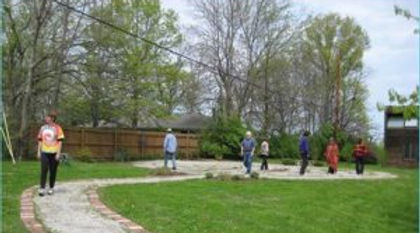Our Labyrinth
Prayer and meditation can be practiced by walking, among other expressions. Unity Center offers an ancient way to “walk” your prayers—on our labyrinth.
What is a labyrinth?
A labyrinth is a pathway for a walking mediation. Labyrinths have been used all around the world dating back as early as 2500 BCE. Unlike a maze, a labyrinth pathway is clearly marked and there is only one way to go. The path leads one to the center and back out.
The labyrinth is a metaphor for the spiritual journey. All we need to do is put one foot in front of the other and stay the course. The path that leads us to our spiritual center, or God, is clearly marked with prayer.
How do I walk it?
The labyrinth is designed to be walked from the entrance into the center and back out following the pathway. To begin, we recommend you take a moment to say a prayer to center yourself. You may also use this time to become aware of a specific prayer intention and keep that in mind during your walk.
Walking the labyrinth path consists of three phases:
-
The path in is an opportunity for letting go or shedding—a way of quieting the mind.
-
The center is the place where we consciously reconnect with our Source. Often people will linger a while in the middle and pray or meditate.
-
The path out is for integration. Having brought ourselves back to the peaceful center, we move out on the path to express in the world again.
Please stay on the path and do not walk across the lines. If others are walking behind you and you wish to walk more slowly, simply pause and allow them to pass you on the left. Similarly, if you are walking in opposite directions and there isn’t enough room, pause and allow the other to pass.
More about the labyrinth
The labyrinth at Unity of Columbia was constructed by members of Unity and is available for community-wide use. Unity’s labyrinth is a unique design starting with the classical seven-circuit made circular with Chartres-style petals in the middle. In order to accommodate the three-foot-wide paths needed for wheelchair access, the labyrinth has five circults instead of seven and the center contains five petals instead of six. The petal-shaped frame in the center was made by metal artist Don Asbee. The base of the pathways is made of chat and lined with bricks. Some of the bricks were purchased by individuals and engraved with inspirational messages or in memory of a dear one.
